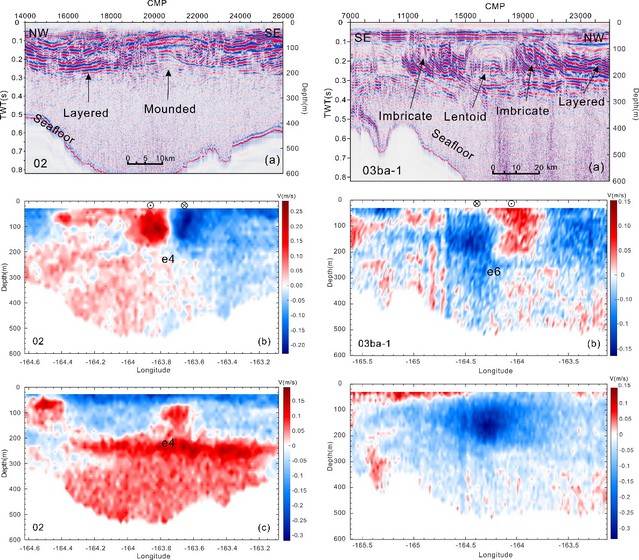Kun Zhang1, Haibin Song1,*, Bernard Coakley2, Shun Yang1, and Wenhao Fan1
1 State Key Laboratory of Marine Geology, School of Ocean and Earth Science, Tongji University, Shanghai 20092, China.
2 Geophysical Institute, University of Alaska, Fairbanks, AK 99775, USA.
Abstract
Halocline eddies transport mass and energy across the Arctic Ocean. Seismic oceanography uses multichannel seismic reflection (MCS) data to create high resolution images of the water column, revealing oceanic fine structures. In this paper, we present water column images processed from MCS data acquired during cruise MGL1112 on the Chukchi Borderlands in the western Arctic Ocean. Combined with along-track images of current velocities measured during MCS acquisition by a hull-mounted ADCP, a total of 23 mesoscale eddies were detected, of which 19 are anticyclonic, and 4 are cyclonic. They correspond to the lentoid and mounded reflections on the seismic images, respectively. These shallow eddies are constrained by the halocline and occur in regions with rugged seafloor. The geometric parameters of these eddies were estimated from the underway data collected during MGL1112. These parameters could be valuable for modeling 3D eddy structures and validating high-resolution climate projection models. Expendable Bathythermography (XBT) profiles of water temperature and sound speed versus depth were collected during this ruise. Three of the 24 XBT stations sampled eddies opportunely, we found one was warm-core and two were cold-core anticyclonic eddies combined with historical CTD data. The cores of these eddies might be made up of Pacific water. We synthesized the MCS records with coincident and historical hydrographic data which permitted distinctions between the seismic responses of the eddies. Distinctive reflection structures are observed around the eddy core (e.g., chaotic, imbricate, layered, and listric reflections), which could constrain stirring and mixing process of the eddies. These results are useful for better understanding the structure and evolution of the eddies on the Chukchi Borderlands and better understanding regional mass and energy transport processes in the western Arctic Ocean.
Plain Language Summary
Eddies rotating masses of water are a ubiquitous feature of the western Arctic Ocean. They transport heat, salt, and nutrients from the Pacific to the surface layer of the Arctic Ocean. Eddies on the Chukchi Borderlands were imaged with seismic waves (i.e., acoustic waves) and characterized with coincident current velocity and temperature data. We have also mapped the eddy distribution and estimated their structural parameters. The seismic images are high resolution and show fine structures associated with eddies. We discussed the structures observed in the seismic images. These structures could directly indicate eddies' stirring and mixing processes. This study helps provide a nearly synoptic, detailed view of the variety eddies in the Chukchi Borderlands, the western Arctic Ocean.
Full Article:https://agupubs.onlinelibrary.wiley.com/doi/10.1029/2022JC018453


